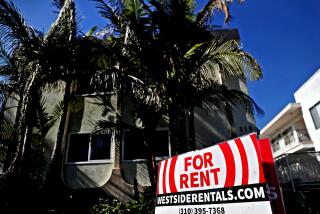Profits and Pitfalls of Acquiring Homes With Lease-Options
- Share via
If you want to buy a home, are you short of cash or would you like to control property without investing large amounts of cash? If you already own a home, are you having trouble selling it or would you like to rent it to top-quality tenants so you can enjoy the tax benefits?
A lease with option to purchase can be the answer. However, while lease-options can be beneficial to both parties, there also are pitfalls to avoid.
Most renters understand a lease gives the tenant the use of a property in return for payment of rent. But an option to buy the property in the future can be added to a lease, thereby creating special benefits for both landlord and tenant.
Under a lease-option the tenant has the opportunity to buy the property for an agreed price. Although the lease-option tenant is not obligated to buy the property, the landlord must sell if the tenant exercises the purchase option.
To compensate for this landlord drawback, the tenant usually pays a “non-refundable consideration for the option,” such as $1,000 to $5,000, or more. This fee substitutes for a tenant security deposit. The larger the non-refundable consideration for the option, the better the chances that the tenant will exercise the option. This money is credited toward the down payment when the option is exercised. If the option is not exercised, the option money is forfeited by the tenant.
Many prospective home buyers have good income but lack a down payment. The lease-option can solve this problem by letting the tenant rent while saving to buy the home. Another advantage is that the tenant can try out the house before buying.
Usually a rent credit toward the down payment, such as 25% to 50%, can be negotiated if the tenant is willing to pay above-market rent. For example, a house that would rent for $1,000 per month might be rented for $1,200 if the landlord agrees to give a 50% rent credit of $600 monthly.
From the landlord’s viewpoint, the lease-option benefits usually include above-market rent and a high-quality tenant who takes pride in the home because the tenant wants to eventually buy it.
Option Price Locked In
Another landlord benefit is that the option price can be set slightly higher than today’s market value if home prices are expected to appreciate in the area during the option term, typically one or two years.
A major lease-option drawback for the landlord is that the option price is usually locked in when the lease-option is signed. If home prices rise rapidly, the owner may lose out, while the tenant benefits when the option is exercised at yesterday’s option price. However, usually no sales commission is payable on lease-options, so this saving helps make up for the landlord’s loss in a rising market.
From the tenant’s viewpoint, locking in the option purchase price is good if home prices rise. However, if they are stagnant or fall, the purchase option won’t have much value. Some landlords want to leave the option price open, subject to an appraisal when the option is exercised, but most tenants will not accept such an open-ended option.
Few lease-options are advertised. One reason is that most realty agents do not like lease-options because they don’t understand their benefits. When I purchased my home on a lease-option, after I explained the benefits to my agent, everything went smoothly. Part of the option consideration money can go to the realty agent, with the balance of the sales commission payable when the option is exercised.
However, most lease-options do not involve realty agents. One way to create a lease-option is to read the “houses for rent” newspaper classified ads. After you inspect a house you like, ask the owner to lease it with an option to buy.
Lease-Option Candidates
Because the rental market for houses is soft in most cities, many owners will agree to a lease-option, especially after you explain that the owner will be receiving non-refundable consideration for the option and higher than market rent in return for a rent credit toward the down payment. Be sure also to explain that as a future owner, you will take good care of the property.
Incidentally, the best lease-option candidates are houses that have been for rent or for sale for several months, need fix-up work, are vacant and are owned by a motivated owner who needs a small amount of immediate cash.
On the other hand, if you are a property owner with a home that is hard to sell, try running a newspaper ad such as “$5,000 Moves You In” under both “Houses for Rent” and “Houses for Sale.” Then get ready for your phone to ring constantly with anxious buyers eager to lease-option the house.
After the terms of the lease-option have been agreed upon, such as the rent, rent credit and the option purchase price, be sure to put everything in writing to avoid misunderstandings. Either use a printed lease-option form or consult a real estate attorney.
If you are an investor and will not be living in the property, be sure to record a memorandum of the option, just in case an unscrupulous owner tries to sell the property without your knowledge.
Lease-options are good for both renter and landlord. But, care should be taken to anticipate any problems and to protect both parties with a well-written agreement.
More to Read
Inside the business of entertainment
The Wide Shot brings you news, analysis and insights on everything from streaming wars to production — and what it all means for the future.
You may occasionally receive promotional content from the Los Angeles Times.










